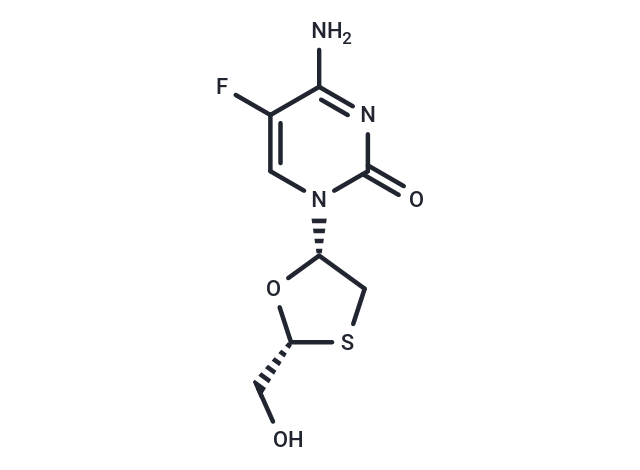Shopping Cart
- Remove All
 Your shopping cart is currently empty
Your shopping cart is currently empty

Emtricitabine is a nucleoside reverse transcriptase inhibitor with anti-human immunodeficiency virus (HIV) and hepatitis B virus activity, with an EC50 value of 0.01 µM in PBMC cells, and can be used to study HIV infection.

| Pack Size | Price | Availability | Quantity |
|---|---|---|---|
| 50 mg | $45 | In Stock | |
| 100 mg | $68 | In Stock | |
| 500 mg | $113 | In Stock |
| Description | Emtricitabine is a nucleoside reverse transcriptase inhibitor with anti-human immunodeficiency virus (HIV) and hepatitis B virus activity, with an EC50 value of 0.01 µM in PBMC cells, and can be used to study HIV infection. |
| Targets&IC50 | NRTI:0.01 µM(EC50) |
| In vitro | METHODS: Vero E6 cells were treated with Emtricitabine (25, 50, 100 μM), and the SARS-CoV-2 titers obtained before and after treatment were measured. The MTT assay was used to evaluate the cytotoxicity of Emtricitabine against Vero E6 cells. RESULTS Emtricitabine showed anti-SARS-CoV-2 activity at 100 μM (59.6%), 50 μM (43.4%), and 25 μM (33.3%). [5] |
| In vivo | Reproductive and developmental toxicology studies conducted on emtricitabine show a favorable pre-clinical safety profile. When administered orally at doses up to 1000 mg/kg/day, pregnant animals experienced emtricitabine exposure levels (AUC0→24) approximately 60-fold (in mice) to 120-fold (in rabbits) higher than the human exposure at the recommended 200 mg daily dosage. Findings from a mouse fertility study indicate that emtricitabine does not impact fertility, sperm count, or early embryonic development. Additionally, there was no observed increase in malformations in mouse and rabbit embryofetal toxicology studies, nor did emtricitabine affect the development and fertility of the F1 progeny in a mouse pre- and post-natal study. These results underscore emtricitabine's lack of adverse effects on reproductive and developmental outcomes[6]. |
| Cell Research | EA.hy926 cells were plated in a 12-, 24- or 96-well plates and grown in DMEM media supplemented with 3% FCS. Endothelial cells from PARP+/+and PARP-/- mice were isolated and cultured. Cell viability was determined by the reduction of yellow MTT into a purple formazan product by mitochondrial dehydrogenases of metabolically active cells. Following the treatment period, the experimental medium was removed and 100 μL MTT (1 mg/mL) added. After 1 h incubation, the MTT solution was carefully removed and the purple crystals were solubilized in 100 μL of DMSO. The DMSO was transferred to an ELISA plate and absorbance measured at 550 nm with a 620 nm[3]. |
| Alias | FTC, Emtriva, BW1592 |
| Molecular Weight | 247.25 |
| Formula | C8H10FN3O3S |
| Cas No. | 143491-57-0 |
| Smiles | Nc1nc(=O)n(cc1F)[C@@H]1CS[C@H](CO)O1 |
| Relative Density. | 1.82 g/cm3 (Predicted) |
| Storage | store at low temperature,keep away from direct sunlight | Powder: -20°C for 3 years | In solvent: -80°C for 1 year | Shipping with blue ice. | |||||||||||||||||||||||||||||||||||
| Solubility Information | DMSO: 50 mg/mL (202.22 mM), Sonication is recommended. | |||||||||||||||||||||||||||||||||||
Solution Preparation Table | ||||||||||||||||||||||||||||||||||||
DMSO
| ||||||||||||||||||||||||||||||||||||

Copyright © 2015-2025 TargetMol Chemicals Inc. All Rights Reserved.